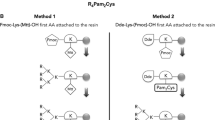Abstract
An aluminium hydroxide adjuvant induced a more elevated and rapid immune responses against short peptides conjugated to the Keyhole Lympet Hemocyanin carrier than immuneasy adjuvant. Furthermore, since carrier proteins may compete with the fused or chemically linked polypeptides in eliciting antigen-specific immune response, we classified the immunogenicity of the most common carrier proteins used in molecular biology for antigen expression and mouse immunisation. The disulfide isomerase protein A gave a carrier with the lowest immunogenicity whilst disulfide isomerase protein C gave the highest immunogenicity and therefore should be avoided as a fusion partner. Using this protein as a model, we identified and located the immunodominant epitopes along its sequence. These results now enable the combination of carrier and immunisation conditions to be optimized.




Similar content being viewed by others
References
Bossi S, Ferranti B, Martinelli C, Capasso P, de Marco A (2010) Antibody-mediated purification of co-expressed antigen-antibody complexes. Protein Express Purif. doi:10.1016/j.pep.2010.01.003
Chiarella P, Massi E, De Robertis M, Signori E, Fazio VM (2007) Adjuvant in vaccines and for immunisation: current trends. Expert Opin Biol Ther 7:1551–1562
De Marco V, Stier G, Blandin S, de Marco A (2004) Comparison of NusA and GST as fusion partners for recombinant expression in E. coli. Biochem Biophys Res Commun 322:766–771
De Masi F, Chiarella P, Wilhelm H, Massimi M, Bullard B, Ansorge W, Sawyer A (2005) High-throughput mouse monoclonal antibodies using antigen microarrays. Proteomics 5:4070–4081
Di John D, Torres JR, Murillo J, Herrington DA et al (1989) Effect of priming with carrier on response to conjugate vaccine. Lancet 2:1415–1418
Dümmler A, Lawrence AM, de Marco A (2005) Simplified screening for the detection of soluble fusion constructs expressed in E. coli using a modular set of vectors. Microb Cell Fact 4:34
Herzenberg LA, Tokuhisa T, Herzenberg LA (1980) Carrier-priming leads to hapten-specific suppression. Nature 285:664–667
Kirkley JE, Goldstein AL, Naylor PH (2001) Effect of peptide-carrier coupling on peptide-specific immune response. Immunobiology 203:601–615
Krieg AM (1990) Mechanisms and applications of immune stimulatory CpG oligodeoxynucleotides. Biochim Biophys Acta 1489:107–116
Mutwiri G, Gerdts V, Lopez M, Babiul LA (2007) Innate immunity and new adjuvants. Rev Sci Tech 26:147–156
Sad S, Gupta HM, Talwar GP, Raghupathy R (1991) Carrier induced suppression of the antibody response to a “self” hapten. Immunology 74:223–227
Schutze MP, Deriaud E, Przewlocki G, LeClerc C (1989) Carrier-induced epitopic suppression is initiated through clonal dominance. J Immunol 142:2635–2640
Tang HY, Speicher DW (2004) Identification of alternative products and optimization of NTCB cyanylation and cleavage at cysteine residues. Anal Biochem 334:48–61
Wilson-Welder JH, Torres MP, Kipper MJ, Mallapragada SK, Wannemuehler MJ, Narasimhan B (2009) Vaccine adjuvants: current challenge and future approaches. J Pharm Sci 98:1278–1316
Acknowledgments
The authors wish to thank N. Rosenthal and C. Boulin for having made accessible the EMBL Facilities and M. Leuener and C. Fasci for technical assistance. PC is supported by FIRB-Idee Progettuali RBIP0695BB_001.
Author information
Authors and Affiliations
Corresponding author
Additional information
Purpose of work
Short-peptide immunisation remains a trial-and-error procedure; however, single components of the protocol, like the rational choice of carriers and adjuvants that can influence the animal immune response, can be optimized.
Rights and permissions
About this article
Cite this article
Chiarella, P., Edelmann, B., Fazio, V.M. et al. Antigenic features of protein carriers commonly used in immunisation trials. Biotechnol Lett 32, 1215–1221 (2010). https://doi.org/10.1007/s10529-010-0283-z
Received:
Accepted:
Published:
Issue Date:
DOI: https://doi.org/10.1007/s10529-010-0283-z




